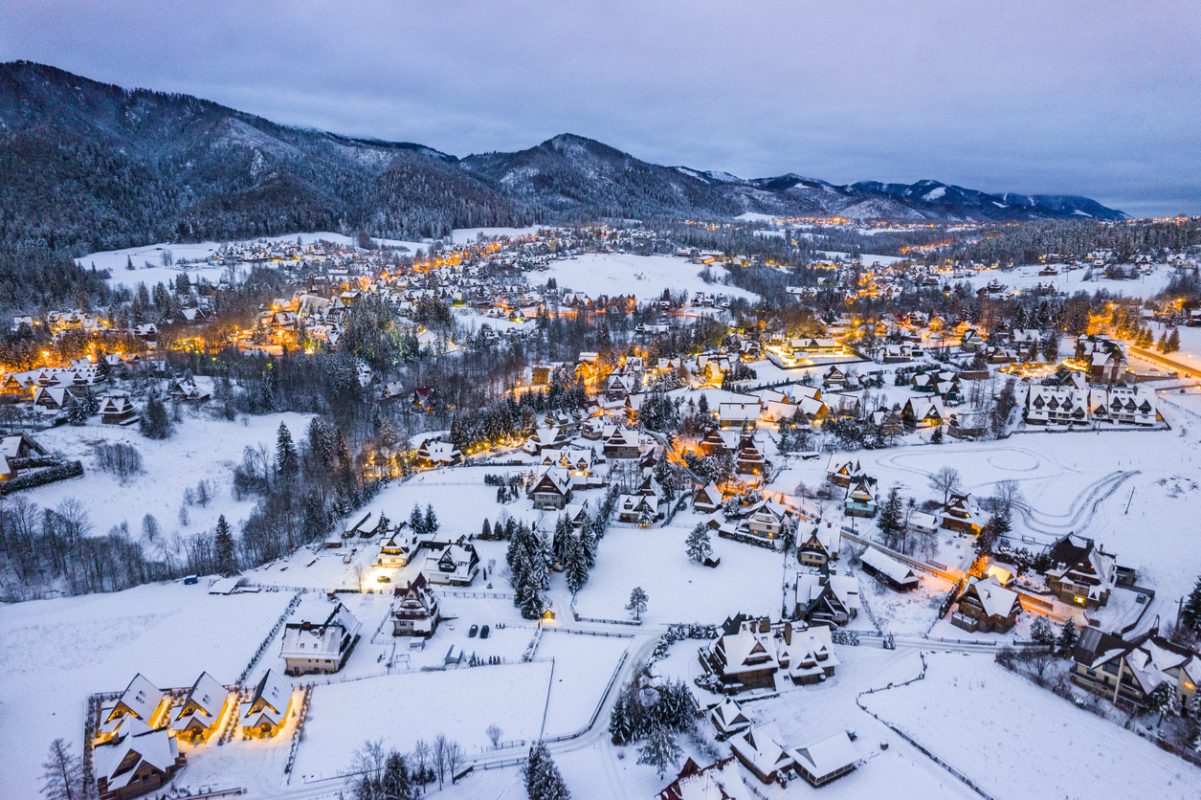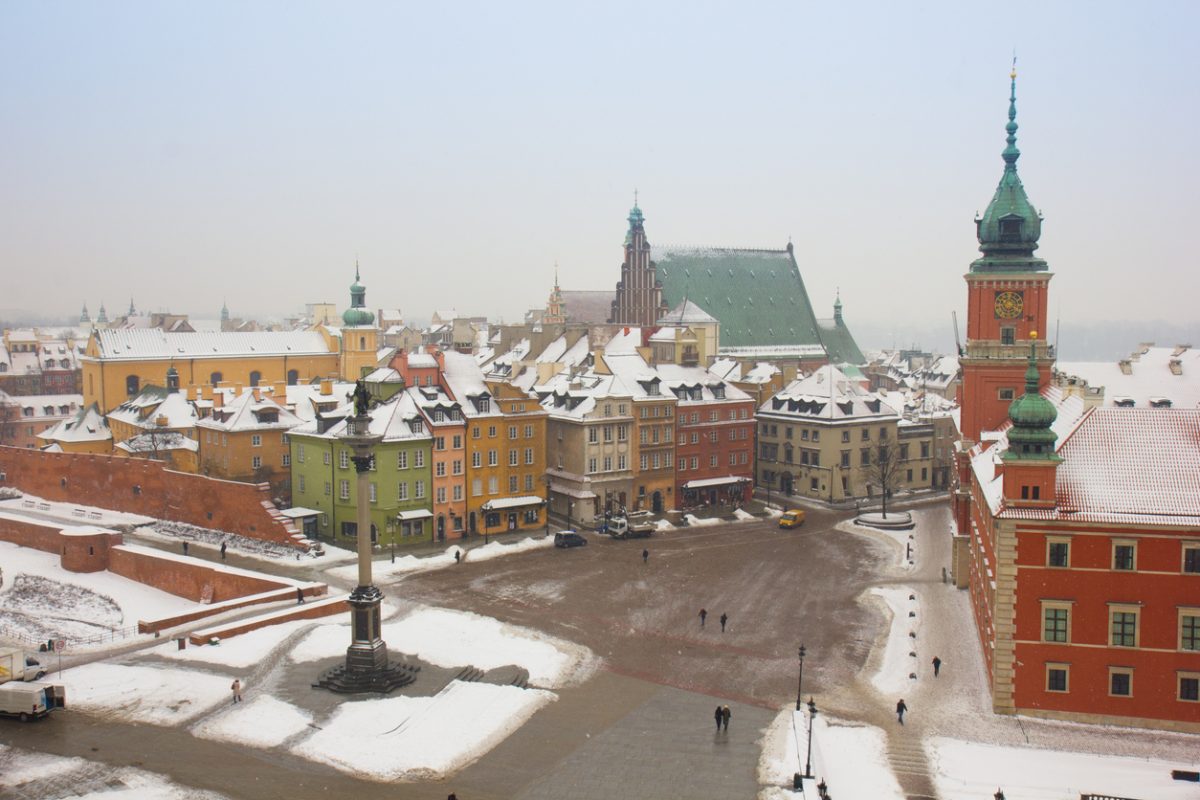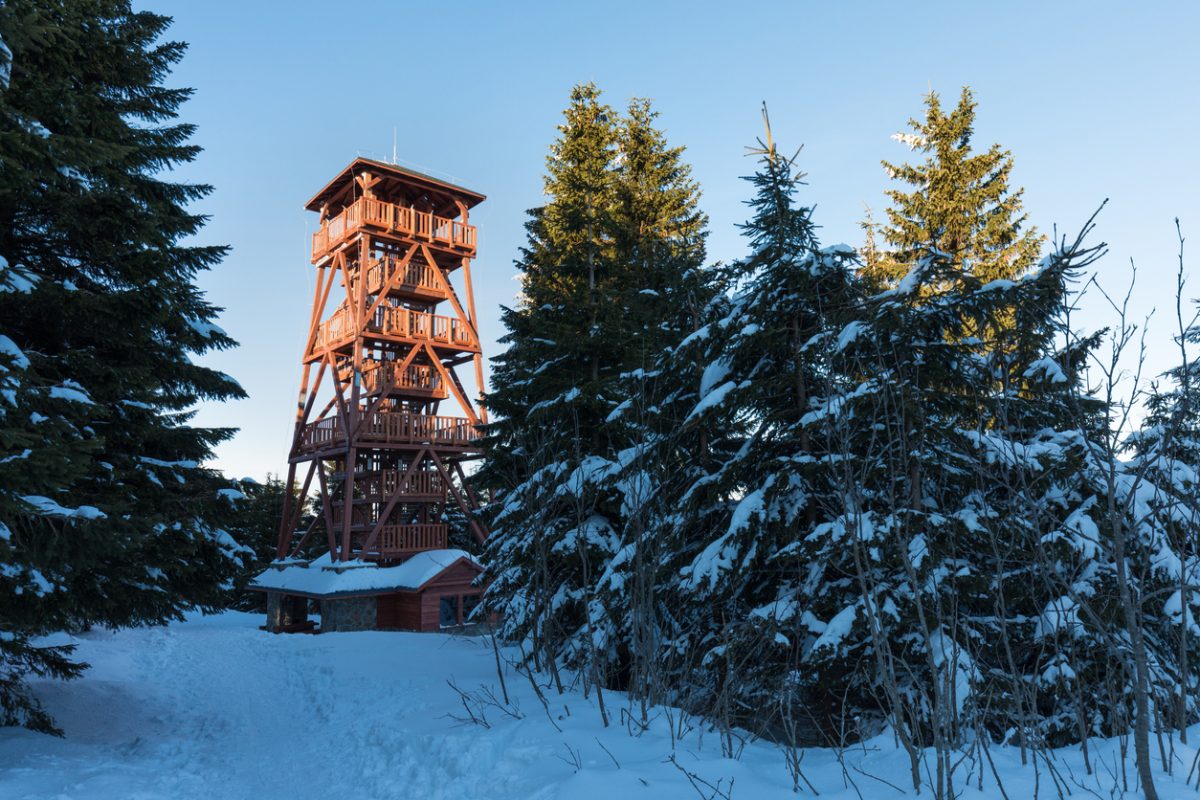Does it snow in Poland? Here’s what winter weather in Poland you can expect!
In Poland in winter, average temperatures plummet and the chance of snow increases.
While the snowiest months are January and February and you’ll find heavier snowfall in the mountains, other destinations have a moderate climate where snow is rare and melts quickly.
But regardless, it’s quite a cold country in winter in general, and snow’s possible anywhere!
Here’s all you need to know about snowfall in Poland!
Does it snow in Poland?

Yes, it does snow in Poland!
Snowfall is common during the winter months, typically from late November to early March.
But the frequency and intensity of snowfall vary significantly depending on the region.
It snows most in the mountains, but you’ll find freezing conditions across the country in the winter season.
When does it snow in Poland?

The first flakes of snow usually appear in late November and snowfall becomes more regular through December, January, and February.
By March, the snow starts to dwindle as the country heads into spring.
The snow season can vary depending on your location within Poland.
For instance, snowy winters in the mountainous regions can begin as early as October, while in the western areas, they may not appear until December.
Does it snow in Poland in November?
November means the beginning of winter for much of Poland, but it’s especially true for the Carpathian and Sudeten mountain ranges – it’s possible to see a layer of snow as early as October.
In November, snowfall really starts to coat these high-altitude areas, paving the way for winter sports like skiing and snowboarding.
If you’re keen to catch an early snow-covered landscape, head to these mountainous regions!
Does it snow in Poland in December?
Come December, snowfall becomes more widespread across Poland.
It’s the perfect time for a festive break, with snowfall gently falling around Poland’s city’s historic squares.
The northern regions like Warsaw experience fairly consistent snow, although not as intense as the mountainous areas.
Here, the snowfall can accumulate quickly.
Even areas by the Baltic Sea start to see a bit of the white stuff!
Does it snow in Poland in January?
January is a peak month for snowfall in Poland, especially in regions like the Tatra Mountains.
Snow is almost a daily occurrence, often accumulating to significant depths.
This is an excellent time for winter sports, and the slopes are abuzz with skiiers and snowboarders.
There are also some winter festivals this month.
Does it snow in Poland in February?
There are plenty of days of snow in Poland in February, particularly in popular winter destinations like Zakopane in the southern Tatra Mountains.
The conditions are ideal for various winter activities, including skiing and snowboarding.
The snow is often powdery, providing excellent conditions for these sports.
Does it snow in Poland in March?
As March rolls in, the frequency and intensity of snowfall begin to decline.
While you’ll still find ample snow in mountainous regions, other parts of the country start seeing signs of spring!
Snowfall becomes less consistent, and temperatures start to rise, gradually melting the existing snow cover.
Where does it snow in Poland?

Poland’s diverse geography means there’s a variety of snowfall patterns, although it can snow pretty much anywhere.
Here’s a region-by-region breakdown:
Northern Poland (Gdańsk, Olsztyn)
The northern regions of Poland, particularly Gdańsk and Olsztyn, are very cold – the sea is Baltic, after all – but it also has a moderating effect on the climate, making the winters milder compared to inland areas.
Snow’s frequent but generally not as intense.
Western Poland (Wrocław, Poznań)
In the western parts of the country, including cities like Wrocław and Poznań, snowfall is less frequent.
While you can expect some snow, it’s less consistent than in other parts of Poland like the Tatra Mountains.
And when snow does fall, it’s often lighter and less likely to accumulate to great depths.
Eastern Poland (Warsaw, Lublin)
The eastern regions, where you’ll find cities like Warsaw and Lublin, usually have cold winters with more sporadic snowfall.
These areas are further from any moderating bodies of water, leading to colder temperatures and the potential for intense snowfall – although the air’s often very dry.
The snow that does fall, however, tends to stick around due to the colder climate.
Southern Poland (Kraków, Zakopane)
Southern Poland is where you’ll encounter the most intense snowfall, especially in mountainous areas around Kraków, such as Zakopane.
These areas are part of the Carpathian and Tatra Mountain ranges and experience long-lasting snow from late October to early April.
Snow accumulation can be significant, making this region the go-to destination for winter sports enthusiasts!
Does it snow in Warsaw?
Yes, it snows in Warsaw throughout the winter season – although it’s not as common as Poland’s mountainous areas.
However, there’s a high chance of seeing some snow in Warsaw in the winter!
Check out my full guide to snowfall in Warsaw.
Does it snow in Kraków?
Yes, snow in Kraków is quite common, especially as it’s close to Southern Poland’s mountains.
You’re likely to encounter freezing weather in Krakow throughout the winter period, particularly in January and February.
Check out my complete guide to snow in Krakow.
Why does it snow in Poland?

So, why is there so much snowfall in Poland compared to other European countries?
Poland’s latitude means cold winters.
As you move away from the equator, temperatures drop, increasing the likelihood of snowfall.
Poland’s latitude means it has a wintery climate where snow is much more than just a fleeting phenomenon!
Another contributing factor to Poland’s snow is its varied elevation.
The Tatra and Carpathian mountain ranges in the south offer perfect conditions for snowfall, often heavy, that can last from late October to early April.
Even at lower elevations, the geographic diversity contributes to varied snowfall patterns across the country.
Wind currents also play a role in determining Poland’s snowfall.
Northern winds sweeping down from Scandinavia and the Arctic can bring cold air, facilitating snowfall.
Similarly, eastern winds from continental Europe can make the climate colder and more conducive to snow, especially in the eastern parts of the country.
Best places for skiing in Poland
Skiing enthusiast? There’s plenty to love in Poland, from beginner-friendly slopes to challenging runs for experienced skiers!
Here are the top spots!
Zakopane

Known as the “winter capital” of Poland, Zakopane in the Tatra Mountains boasts a variety of slopes suitable for all skill levels.
Here you’ll find well-groomed pistes and ample amenities, from ski rentals to cosy mountain lodges.
If you’re new to skiing, this is the ideal starting point – with plenty of ski schools offering lessons.
Check out my full guide to Zakopane in winter here.
Szczyrk
Located in the Beskid Śląski Mountains, Szczyrk is another must-visit ski destination.
It’s particularly popular among intermediate skiers, with a modern lift system.
The area has recently seen investments in slope improvements, making it one of the more advanced ski resorts in Poland.
Karpacz
Situated in the Karkonosze Mountains, Karpacz incorporates slopes that cater to a range of skill levels.
The resort is known for its well-maintained runs and good snow conditions.
If you’re an advanced skiier, you might love some of the steeper sections.
Białka Tatrzańska
Near Zakopane, Białka Tatrzańska is another, slightly quieter, option in the Tatra Mountains.
It’s ideal for families or those looking to escape the crowds.
The resort has a range of slopes and is generally less busy.
Wisła
Nestled in the Beskid Śląski Mountains, Wisła is a suitable destination for beginner and intermediate skiers.
The area offers several ski lifts and varied slopes; there’s something for everyone here!
Tips for visiting Poland in the snow

Here’s all you need to know about visiting Poland in the snow:
Accurate weather forecasts
Before you venture out, consult reliable weather services like the Institute of Meteorology and Water Management in Poland.
Knowing the forecast helps you dress appropriately and plan your activities.
Dress code
Layering is crucial when dealing with Poland’s winter.
Start with thermal underwear and add layers, including a fleece or wool sweater, waterproof outerwear, and insulated boots.
Don’t forget hats, gloves, and scarves to protect your extremities.
Safety measures
If you plan to drive, road conditions can change rapidly with snow and ice.
Always carry a winter car emergency kit that includes items like a snow shovel, ice scraper, and tire chains.
Stick to well-maintained roads and keep an eye out for updated road condition alerts.
Public transport
When it’s snowing heavily, you might want to avoid driving altogether.
Poland’s public transport systems are generally reliable and can get you to most tourist destinations without the hassle of navigating slippery roads.
Off-peak attractions
Consider visiting attractions that are less crowded during winter but equally breathtaking when covered in snow.
For instance, the Białowieża Forest is magical when blanketed in white, and you’re more likely to spot native wildlife like the European bison.
Footwear
Given that you’ll be navigating snowy and icy paths, sturdy, waterproof boots with good grip are essential.
You don’t want to miss out on exploring because you’re not properly equipped!
FAQS for visiting Poland in the snow

Here are some answers to FAQs about snow in Poland.
Does Poland have snow?
Yes, Poland sees snowfall during its winter months, typically from late November to early March.
The frequency and amount of snow vary depending on the region and elevation.
Which part of Poland has snow?
Snowfall is most frequent and intense in southern Poland, especially in mountainous regions like the Tatra and Sudeten Mountains.
Northern Poland near the Baltic Sea also sees consistent snow, though usually less than the southern regions.
What is the month of snowing in Poland?
Snow generally starts falling in late November and can continue through early March.
December and January often have the most consistent snowfall.
The actual timing can vary based on region and specific weather conditions.
What is Poland like in winter?
Poland in winter is characterized by shorter days and colder temperatures, often dropping below freezing.
The country turns into a winter wonderland with various winter sports and activities, such as skiing and snowboarding, becoming popular in regions like Zakopane.
Is Poland colder than the UK?
Poland tends to have colder winters compared to the UK.
While the UK experiences milder winters due to the influence of the Atlantic Ocean, Poland sees colder temperatures and more frequent and intense snowfall.
Is Poland snowy at Christmas?
While it’s not guaranteed, many regions in Poland, particularly in the south, are likely to have snow around Christmas time.
The chances of a white Christmas are higher in the mountainous areas like Zakopane.
Does it snow every year in Poland?
Snow is a regular feature of Polish winters, and there will always be snowfalls at some point in the winter.
However, the amount and timing can vary from year to year and region to region.
Is Poland worth visiting in winter?
Absolutely! Poland offers a range of winter activities, from skiing in the Tatra Mountains to exploring historic cities like Kraków and Warsaw under a blanket of snow.
Winter also means unique cultural experiences, it’s an ideal time to immerse yourself in local traditions.

